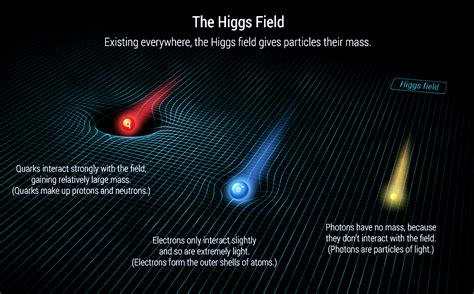The Higgs field, a fundamental concept in particle physics, has long been a subject of fascination and intrigue. Named after physicist Peter Higgs, who first proposed its existence in the 1960s, the Higgs field is a theoretical framework that explains how particles acquire mass. In this article, we will delve into the intricacies of Higgs field physics, exploring its history, key components, and the groundbreaking experiments that have confirmed its existence.
The Origins of the Higgs Field
To understand the Higgs field, we must first consider the Standard Model of particle physics, which describes the behavior of fundamental particles and forces in the universe. In the early 1960s, physicists like Peter Higgs, François Englert, and Robert Brout proposed the existence of a field that would explain how particles acquire mass. This field, now known as the Higgs field, is a scalar field that permeates all of space and is responsible for giving mass to fundamental particles.
The Higgs field is often described as a “molasses-like” substance that fills the universe, with particles gaining mass as they interact with it. The more a particle interacts with the Higgs field, the more mass it acquires. This concept revolutionized our understanding of particle physics, providing a framework for understanding the behavior of fundamental particles.
Key Components of the Higgs Field
The Higgs field consists of several key components, including:
- Higgs boson: The Higgs boson is a scalar boson that is the quanta of the Higgs field. It is the particle associated with the Higgs field, and its discovery in 2012 confirmed the existence of the Higgs field.
- Higgs mechanism: The Higgs mechanism is the process by which particles acquire mass through interactions with the Higgs field. It is a fundamental concept in particle physics, explaining how particles gain mass and how the universe evolved to its current state.
- Symmetry breaking: Symmetry breaking is a fundamental concept in particle physics, where a symmetry is broken, leading to the formation of a new phase. In the case of the Higgs field, symmetry breaking occurs when the Higgs field acquires a non-zero value, leading to the formation of a new phase with massive particles.
Experimental Confirmation of the Higgs Field
The existence of the Higgs field was confirmed in 2012 by the ATLAS and CMS experiments at the Large Hadron Collider (LHC). The discovery of the Higgs boson, with a mass of approximately 125 GeV, marked a major milestone in particle physics, confirming the existence of the Higgs field.
The experimental confirmation of the Higgs field involved a complex series of experiments, including:
- Particle collisions: Proton-proton collisions were used to create high-energy collisions, allowing physicists to search for evidence of the Higgs boson.
- Detector technology: Sophisticated detector technology was used to detect and analyze the particles produced in the collisions.
- Data analysis: Advanced data analysis techniques were used to identify the Higgs boson and confirm its existence.
Implications of the Higgs Field
The Higgs field has far-reaching implications for our understanding of the universe. Some of the key implications include:
- Origin of mass: The Higgs field provides a fundamental understanding of how particles acquire mass, explaining why some particles are massive while others are massless.
- Unification of forces: The Higgs field provides a framework for understanding the unification of forces, including the electromagnetic, weak, and strong nuclear forces.
- Cosmology: The Higgs field plays a crucial role in our understanding of the early universe, including the formation of structure and the evolution of the universe.
Understanding the Higgs Field: A Step-by-Step Guide

- Introduction to the Standard Model: Understand the fundamental particles and forces in the universe.
- Higgs Field Basics: Learn about the Higgs field, including its key components and the Higgs mechanism.
- Experimental Confirmation: Discover how the Higgs boson was detected and confirmed.
- Implications of the Higgs Field: Explore the far-reaching implications of the Higgs field for our understanding of the universe.
Future Directions
The discovery of the Higgs field marks the beginning of a new era in particle physics. Future experiments, including the LHC and future colliders, will continue to explore the properties of the Higgs field, including its self-interactions and interactions with other particles.
Some of the key questions that remain to be answered include:
- Higgs self-interactions: What are the self-interactions of the Higgs field, and how do they affect the behavior of particles?
- Higgs interactions with other particles: How does the Higgs field interact with other particles, including the top quark and the W and Z bosons?
- Beyond the Standard Model: What lies beyond the Standard Model, and how can the Higgs field be used to explore new physics?
What is the Higgs field, and how does it give mass to particles?
+The Higgs field is a scalar field that permeates all of space and is responsible for giving mass to fundamental particles. Particles gain mass as they interact with the Higgs field, with the more they interact, the more mass they acquire.
What is the Higgs boson, and how was it discovered?
+The Higgs boson is a scalar boson that is the quanta of the Higgs field. It was discovered in 2012 by the ATLAS and CMS experiments at the Large Hadron Collider (LHC), confirming the existence of the Higgs field.
What are the implications of the Higgs field for our understanding of the universe?
+The Higgs field has far-reaching implications for our understanding of the universe, including the origin of mass, the unification of forces, and the evolution of the universe.
In conclusion, the Higgs field is a fundamental concept in particle physics that explains how particles acquire mass. The discovery of the Higgs boson in 2012 marked a major milestone in particle physics, confirming the existence of the Higgs field and providing a fundamental understanding of the universe. As we continue to explore the properties of the Higgs field, we may uncover new secrets about the universe, including the origin of mass and the unification of forces.



